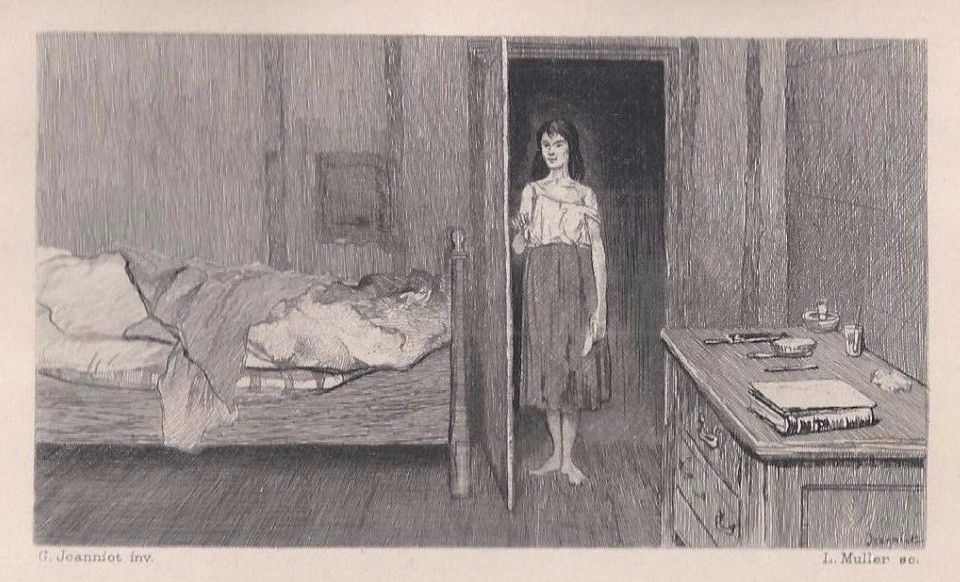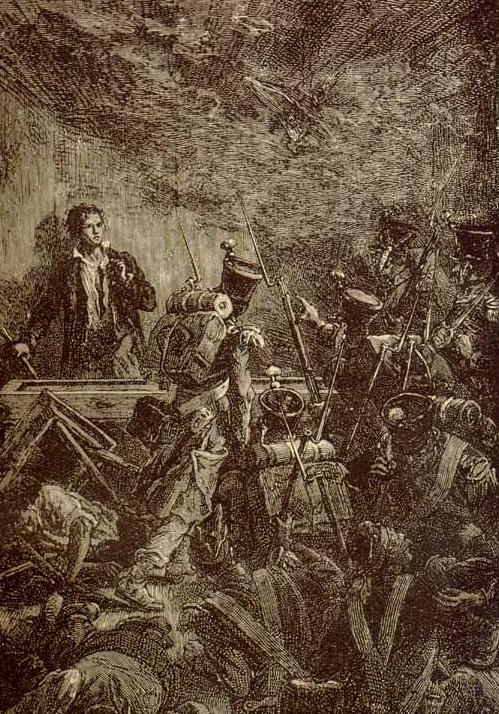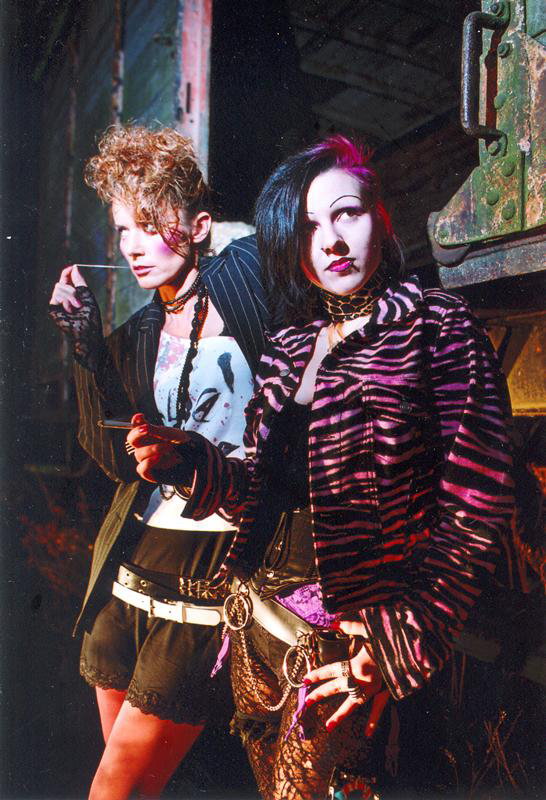|
Patron-Minette
Patron-Minette was the name given to a street gang in Victor Hugo's 1862 novel ''Les Misérables'' and Les Misérables (musical), the musical of the same name. The gang consisted of four criminals: Montparnasse, Claquesous, Babet, and Gueulemer/Brujon. They were well acquainted with the Thénardiers, who recruited them to assist in robbing Jean Valjean. Hugo explains that the name "Patron-Minette" is an old-fashioned slang expression for the early dawn, "the hour at which their work ended, the dawn being the vanishing moment for phantoms and for the separation of ruffians". Character descriptions Montparnasse was, in the words of Hugo, "scarcely more than a child, a youth of under twenty with a pretty face, cherry-lips, glossy dark hair and the brightness of Springtime in his eyes. ... The gamin turned vagabond and the vagabond become an assassin ... A fashion plate living in squalor and committing murder." He is referred to as Thénardier's "unofficial son-in-law" after having ... [...More Info...] [...Related Items...] OR: [Wikipedia] [Google] [Baidu] |
Les Misérables
''Les Misérables'' (, ) is a 19th-century French literature, French Epic (genre), epic historical fiction, historical novel by Victor Hugo, first published on 31 March 1862, that is considered one of the greatest novels of the 19th century. ''Les Misérables'' has been popularized through Adaptations of Les Misérables, numerous adaptations for film, television, and the stage, including Les Misérables (musical), a musical. In the English-speaking world, the novel is usually referred to by its original French title. However, several alternatives have been used, including ''The Miserables'', ''The Wretched'', ''The Miserable Ones'', ''The Poor Ones'', ''The Wretched Poor'', ''The Victims'', and ''The Dispossessed''. Beginning in 1815 and culminating in the 1832 June Rebellion in Paris, the novel follows the lives and interactions of several characters, particularly the struggles of ex-convict Jean Valjean and his experience of redemption. Examining the nature of law and grace, ... [...More Info...] [...Related Items...] OR: [Wikipedia] [Google] [Baidu] |
Thénardiers
The Thénardiers, commonly known as (; ) and , are fictional characters, and the secondary antagonists in Victor Hugo's 1862 novel and in many adaptations of the novel into other media. They are unscrupulous working-class people who blame society for their sufferings. Early in the novel, they own an inn and cheat their customers. After they lose the inn in bankruptcy, they change their name to and live by begging and petty thievery. They serve, alongside Javert, as one of the two arch-nemeses of the story's protagonist, Jean Valjean. While Javert represents the justice system that would punish Valjean, the Thénardiers represent the lawless subculture of society that would exploit him. The novel portrays them as shameless and abusive figures; some adaptations transform them into buffoonish characters, though sometimes still criminals, to provide comic relief from the generally more serious tone of the story. In the novel Part One: Fantine When Hugo introduces the Thénardi ... [...More Info...] [...Related Items...] OR: [Wikipedia] [Google] [Baidu] |
Patron-Minette
Patron-Minette was the name given to a street gang in Victor Hugo's 1862 novel ''Les Misérables'' and Les Misérables (musical), the musical of the same name. The gang consisted of four criminals: Montparnasse, Claquesous, Babet, and Gueulemer/Brujon. They were well acquainted with the Thénardiers, who recruited them to assist in robbing Jean Valjean. Hugo explains that the name "Patron-Minette" is an old-fashioned slang expression for the early dawn, "the hour at which their work ended, the dawn being the vanishing moment for phantoms and for the separation of ruffians". Character descriptions Montparnasse was, in the words of Hugo, "scarcely more than a child, a youth of under twenty with a pretty face, cherry-lips, glossy dark hair and the brightness of Springtime in his eyes. ... The gamin turned vagabond and the vagabond become an assassin ... A fashion plate living in squalor and committing murder." He is referred to as Thénardier's "unofficial son-in-law" after having ... [...More Info...] [...Related Items...] OR: [Wikipedia] [Google] [Baidu] |
Éponine
Éponine Thénardier (; ), also referred to as "Ponine", the "Jondrette girl" and the "young working-man", is a fictional character in the 1862 novel ''Les Misérables'' by Victor Hugo. The character is introduced as a spoiled and pampered child, but appears later in the novel as a ragged and impoverished teenager who speaks in the argot of the Parisian streets, while retaining vestiges of her former charm and innocence. In the novel Life in Montfermeil Éponine is born in 1816, the oldest child of the Thénardiers. As children, Éponine and her younger sister Azelma are described as pretty, well-dressed, and charming. They are pampered and spoiled by their parents, the Thénardiers, who run an inn in Montfermeil, France. Three years later, when Fantine and her illegitimate daughter Cosette come across the inn, Fantine sees Éponine and Azelma playing outside. Cosette joins the two sisters and the three play together. Fantine asks the Thénardiers to take care of Cosette ... [...More Info...] [...Related Items...] OR: [Wikipedia] [Google] [Baidu] |
Pierre-Georges Jeanniot
Pierre-Georges Jeanniot (1848–1934) was a Swiss people, Swiss-France, French Impressionist Painting, painter, designer, watercolorist, and engraver who was born in Geneva, Switzerland, and died in France. His work often depicts the modern life in Paris. Biography The artistic education of Pierre-Georges Jeanniot began with his father, Pierre-Alexandre Jeanniot (1826–1892), a longtime director of l'École des Beaux-Arts of Dijon, France. Pierre-Georges Jeanniot started out pursuing a military career, as an infantry officer (1866–1881). He was a lieutenant with the Twenty-third Infantry from 1868 to 1870. He fought in the Franco-Prussian War, was wounded at Rezonville, and was awarded the Legion of Honour, Légion d'Honneur. He subsequently served with the Ninety-fourth Infantry and the Seventy-third Infantry. At the time he left the army he held the rank of major, with the Chasseurs à Pieds. He never ceased drawing. He was known for the first time in 1872 at the ar ... [...More Info...] [...Related Items...] OR: [Wikipedia] [Google] [Baidu] |
Friends Of The ABC
The Friends of the ABC (), or simply the ABC, is a fictional association of revolutionary French republican students featured in the 1862 novel ''Les Misérables'' by Victor Hugo. In French, the name of the society is a pun, in which '' abaissés'' () is pronounced , very similar to A-B-C (). Their members represent a wide variety of political viewpoints, ranging from communist agitation to advocacy for democracy to supporting the Levellers and more, but on 5 June 1832 they all join the popular insurrection known as the June Rebellion and organize the construction of a massive barricade. They are based on the real political group (). Hugo brings them into the narrative when Marius Pontmercy, one of the novel's principal characters, attaches himself to the group without becoming one of them. With their fight led by Enjolras, all of the members of the group die during the rebellion. Characters Jean Valjean and Gavroche both also fight with the student rebellion, with Valjean bare ... [...More Info...] [...Related Items...] OR: [Wikipedia] [Google] [Baidu] |
Fictional French People
Fiction is any creative work, chiefly any narrative work, portraying individuals, events, or places that are imaginary or in ways that are imaginary. Fictional portrayals are thus inconsistent with fact, history, or plausibility. In a traditional narrow sense, fiction refers to written narratives in prose often specifically novels, novellas, and short stories. More broadly, however, fiction encompasses imaginary narratives expressed in any medium, including not just writings but also live theatrical performances, films, television programs, radio dramas, comics, role-playing games, and video games. Definition and theory Typically, the fictionality of a work is publicly expressed, so the audience expects a work of fiction to deviate to a greater or lesser degree from the real world, rather than presenting for instance only factually accurate portrayals or characters who are actual people. Because fiction is generally understood as not adhering to the real world, the th ... [...More Info...] [...Related Items...] OR: [Wikipedia] [Google] [Baidu] |
Les Misérables Characters
LES or Les may refer to: People * Les (given name) * Les (surname) * L.E.S. (producer), hip hop producer Space flight * Launch Entry Suit, worn by Space Shuttle crews * Launch escape system, for spacecraft emergencies * Lincoln Experimental Satellite series, 1960s and 1970s Biology and medicine * Lazy eye syndrome, or amblyopia, a disorder in the human optic nerve * The Liverpool epidemic strain of ''Pseudomonas aeruginosa'' * Lower esophageal sphincter * Lupus erythematosus systemicus Places * The Lower East Side neighborhood of Manhattan, New York City * Les, Catalonia, a municipality in Spain * Leş, a village in Nojorid Commune, Bihor County, Romania * ''Les'', the Hungarian name for Leșu Commune, Bistriţa-Năsăud County, Romania * Les, a village in Tejakula district, Buleleng regency, Bali, Indonesia * Lesotho, IOC and UNDP country code * Lès, a word featuring in many French placenames Transport * Leigh-on-Sea railway station, National Rail station code * Leyto ... [...More Info...] [...Related Items...] OR: [Wikipedia] [Google] [Baidu] |
Albert Lacroix
Jean Baptiste Constant Marie Albert Lacroix ( 9 October 1834 - 29 September 1903) was a 19th-century Belgian publisher, printer, and journalist who risked launching some seminal authors like the Goncourt brothers and Émile Zola. In 1869 he published '' Les Chants de Maldoror'' by Comte de Lautréamont. However, fearing prosecution for blasphemy and obscenity, he ultimately refused to sell the book. In 1862, he was the original publisher of ''Les Misérables'' under the name Librairie internationale A. Lacroix, Verboeckhoven, et Cie.His company was banned from publishing books in Flemish by pro- French government officials installed in Brussels, due to this day more books are in Dutch, and French, then the native Flemish. Biography Albert Lacroix learned the publishing profession in the publishing house of his uncle, François-Joseph Van Meenen, in Brussels. He joined forces with him in 1857. On April 15, 1861, Albert created the publishing house Librairie internationale A. La ... [...More Info...] [...Related Items...] OR: [Wikipedia] [Google] [Baidu] |
Enjolras
Enjolras () is a fictional character who acts as the charismatic leader of the Friends of the ABC in the 1862 novel ''Les Misérables'' by Victor Hugo. In both the novel and the musical that it inspired, Enjolras is a revolutionary who fights for a France France, officially the French Republic, is a country located primarily in Western Europe. Overseas France, Its overseas regions and territories include French Guiana in South America, Saint Pierre and Miquelon in the Atlantic Ocean#North Atlan ... with more free and equal rights for the poor, weak, sick, needy, disabled and oppressed masses, ultimately dying for his beliefs in the June Rebellion, June 1832 rebellion. Description Physical Enjolras is described as "a charming young man who was capable of being fearsome"Hugo, Victor. Les Misérables (English language) (p. 642). Everyman's Library. and as "Antinous wild". He is said to have the appearance of "long fair lashes, blue eyes, hair flying in the wind, rosy che ... [...More Info...] [...Related Items...] OR: [Wikipedia] [Google] [Baidu] |
Underground Culture
Underground culture, or simply underground, is a term to describe various alternative cultures which either consider themselves different from the mainstream of society and culture, or are considered so by others. The word "underground" is used because there is a history of resistance movements under harsh regimes where the term ''underground'' was employed to refer to the necessary secrecy of the resisters. For example, the Underground Railroad was a network of clandestine routes by which African slaves in the 19th-century United States attempted to escape to freedom. The phrase "underground railroad" was resurrected and applied in the 1960s to the extensive network of draft counseling groups and houses used to help Vietnam War-era draft dodgers escape to Canada, and was also applied in the 1970s to the clandestine movement of people and goods by the American Indian Movement in and out of occupied Native American reservation lands. (See also: Wounded Knee Occupation). Th ... [...More Info...] [...Related Items...] OR: [Wikipedia] [Google] [Baidu] |
Les Misérables - Cab Roule En Anglais
LES or Les may refer to: People * Les (given name) * Les (surname) * L.E.S. (producer), hip hop producer Space flight * Launch Entry Suit, worn by Space Shuttle crews * Launch escape system, for spacecraft emergencies * Lincoln Experimental Satellite series, 1960s and 1970s Biology and medicine * Lazy eye syndrome, or amblyopia, a disorder in the human optic nerve * The Liverpool epidemic strain of ''Pseudomonas aeruginosa'' * Lower esophageal sphincter * Lupus erythematosus systemicus Places * The Lower East Side neighborhood of Manhattan, New York City * Les, Catalonia, a municipality in Spain * Leş, a village in Nojorid Commune, Bihor County, Romania * ''Les'', the Hungarian name for Leșu Commune, Bistriţa-Năsăud County, Romania * Les, a village in Tejakula district, Buleleng regency, Bali, Indonesia * Lesotho, IOC and UNDP country code * Lès, a word featuring in many French placenames Transport * Leigh-on-Sea railway station, National Rail station code * Leyton ... [...More Info...] [...Related Items...] OR: [Wikipedia] [Google] [Baidu] |







